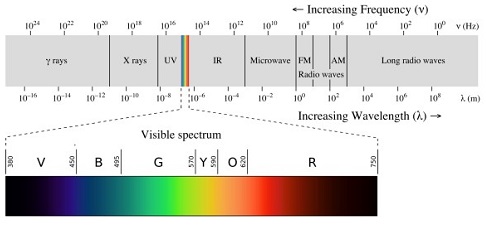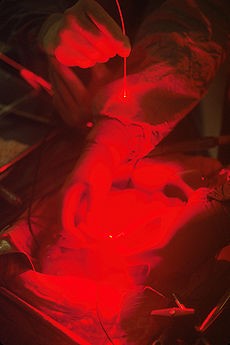Gone may be the days, where the doctor used to pierce needle through the arteries of patient to collect blood sample and test for any perceived ailment. At this horizon of technology, scientists have been able to investigate, design, manufacture and calibrate new procedures to analyze a particular blood cell organelle without the need of collecting it explicitly. Not just in the field of cell biology, but smart medical devices are also making their presence felt in the field of tissue imaging, ophthalmology, neuroscience, orthopaedics, and ear cell regenerations as you will learn through this article.
It is observed that the current trend in developing such medical devices is to bring into play the electromagnetic (EM) waves (as shown in Fig 1), which can penetrate the surface of an organ having a particular thickness depending upon its wavelength. Let it be infrared, visible or ultraviolet – all are able to produce viable positive results for its application in the field of applying engineering in medicine. This article dives deep on such technologies and how it came to be. The most important part of such devices is to design and manufacture the source which would eventually create the electromagnetic waves, directly or indirectly (as it is seen by the conversion from higher energy to lower energy, eg. from blue to red / infrared and use it to expedite wound healing). Also considering the present techno-culture behaviour of miniaturizing everything possible, the source is also prone to be miniaturized, which is only possible by a solid state devices and hence it brings to play opto-solid state devices such as lasers and LED’s.
The article also deals with the role of Food and Drug Administration (FDA) having its headquarters at US and how they rigorously test new medical devices for its safely, legitimacy and its claims.
 |
|
Fig 1: Electromagnetic radiation specturm (photo courtesy of Wikipedia) |
Different radiation parameters for medical devices:
It’s well understood that there are of course many parameters that needs to be manipulated for the use of electromagnetic radiation in medical purposes, but the most important parameters are as follows:
1. Wavelength
2. Energy
3. Intensity
For example, if we have narrow bandwidth light source - it’s a laser source. If we have a broad bandwidth, it’s an LED light source. Likewise combining different wavelength from visible range of LED will result in a compound colour like white.
So we come to a junction wherein we can investigate a new “medical black box” device incubating many inter-linked solid state devices which can generate electromagnetic radiation with different parameters as stated above.
Quite challenging – Yes, but possible. The article takes a leap in motivating individuals to think about ideas of such smart portable medical device which could be taken along patient.
Sunlight as a source of Electromagnetic field:
Few would have ever wondered the use sun light, which is amply available in abundance for all, could be reason itself for mankind to exist on the surface of earth. Sunlight above the Earth’s atmosphere consists of EM radiation ranging from 200nm to 2500nm, wherein only 300nm to 1250nm (and then in modest chunks at the higher wavelength) reaches within the vicinity of our atmosphere as shown in Fig 2.
 |
|
Fig 2: Comparison of irradiation of sun above the atmosphere and once it comes within the vicinity of Earth’s atmosphere (photo courtesy of Wikipedia) |
There are various benefits by presenting our skin under the broad early morning sunlight, like it helps the skin cells to undergo better metabolism. Technically talking it’s all about a particular wavelength and its intensity of solar light incident on the skin which can do wonders. Moreover it’s a well known fact that sunlight helps in producing Vitamin D in the body which helps in getting our bones dense and stronger. All the while in the absence of sunlight, one may even go through a neurochemical imbalance in the brain causing depression illness which is also known as seasonal affective disorder. Taking motivation from such a kind of natural form of EM radiation, one gets its eye on developing synthetic electromagnetic radiation for bio stimulation, also known as Low level light therapy or photonic therapy.
MEDICAL DEVICE CONCEPTS:
This section deals with different medical devices in diverse medical sub fields, some been already developed, while some pinned for research.
Diabetes:
The most general way to test diabetes is to painfully pierce injection and collect blood sample for analysis. Researchers from Massachusetts Institute of Technology (MIT) have now come across a technology wherein infrared light (which ranges from 700nm to 106nm) is shined across the skin and by the principle of Raman Spectrometry; the device identifies chemical compounds in the blood and hence its level of glucose content.
Problem with near infrared light is that it can penetrate short distance into the skin, thus detecting the glucose level of surrounding the skin cell but not of the blood stream. Hence the MIT team has now resolving the problem by using a new algorithm (known as mass transfer model) to relate the blood glucose level with interstitial glucose level. The plan is to make laptop size device and ready to be commercialized at $200.
Wound / Tissue healing:
Way back in 1967, a Hungarian physician Endre Mester used ruby and helium-neon (He-Ne) laser to expedite the wound healing process. From then onwards bio-physicists are trying hard to learn how such a high energy beam of light could help in healing process. MicroLight Corporation located in Missouri City Texas recently developed ML 830 laser which can perform non surgical treatment of carpal tunnel syndrome which is the cause of pain and numbness. ML 830 is now also used in pain management therapy, trigger point therapy for fibromyalgia, sports injury, arthritis and neuromuscular disorder such as Bell's Palsy.
While red to infrared light (632nm - 830nm) is already used as tissue healing for dogs, horse & cats which on a cellular level helps in repairing mitochondrial and messenger DNA to improvise the metabolism and hence promoting healing. Reaching towards higher side of EM spectrum of 830nm has higher tissue penetration and hence higher impact for tissue healing in form of relieving pain.
Moreover recently a group from Boston invented a biodegradable, biocompatible and elastic glue to be used for cardiac wall defects such as holes on hearts. Around 40,000 babies are born with such congenital heart defects just in United States annually. This glue has the property of having high sticking ability even in the presence of high blood content and moving surface as considered the case of heart. The adhesive abilities of the glue is activated by using Ultra violet (UV) light, hence creating anti-bleeding seal within just 5 seconds on application of UV light (100nm to 400nm).
Photodynamic therapy (PDT) (as shown in Fig 3.) is a form of using non toxic light sensitive that are selectively exposed to light, which become toxic to the subjected diseased cells. It is the abiity to kill microbial cells including bacteria, viruses and fungi.
 |
|
Fig 3: Photodynamic Therapy (PDT) in process (photo courtesy of Wikipedia) |
Bone and tissue regeneration:
MedX Health corporation released a device named “Oralase” which uses a continuous wave (CW) 808nm, 200 mW Gallium Aluminium Arsenide (GaAlAs) laser diode with three red LEDs to help reduce bleeding, pain and swelling after dental surgery and also expedite bone regeneration process.
Hearing – Ear cells:
A group from Germany lead by Lutz Wilden came to a conclusion that by using cold laser light, one can improve hearing problems such as tinnitus, ear pressure, over sensitive hearing and even hearing loss. The experiment showed that the synthetic EM wave with wavelengths between 630nm and 830nm enhances the functioning of cell mitochondria to produce Adenosine Tri Phosphate (ATP’s), hence causing accelerated regeneration of hearing cells.
Food and Drug Administration (FDA):
A company in US needs to strictly follow a procedure before launching a new device in the global market. The FDA checks its legitimacy, investigates safety, claims and labelling on such devices. FDA has been a most important department for clearing the medical device for commercial purpose. Likewise it took 12 years, with two double blind studies and $4 million fees for the ML 830 laser to be used for non surgical treatment of carpal tunnel system.
In the recent happenings, FDA had accepted MiSeqDx of Illumina (San Diego, CA) which is a next generation gene sequencing devices (NGS) in the field of genomics. This device is used to detect the DNA changes in the cystic fibrosis transmembrane conductance regulator (CFTR) gene which may result in cystic fibrosis(CF) which affects the lungs, intestines, liver, pancreas and other organs of those who inherit faulty CFTR gene. This technique will help understand different genes related causes of disease in patients.
Author: Mr. Uttam M. Pal is a Technology Analyst at De Core Science & Technologies Ltd., India. He completed his masters from Electrical Dept., IIT Bombay and since working here. His field of interest lie in Photonics, Biophysics and opto-semiconductor physics. He can be reached at upa@dstlworld.com.














